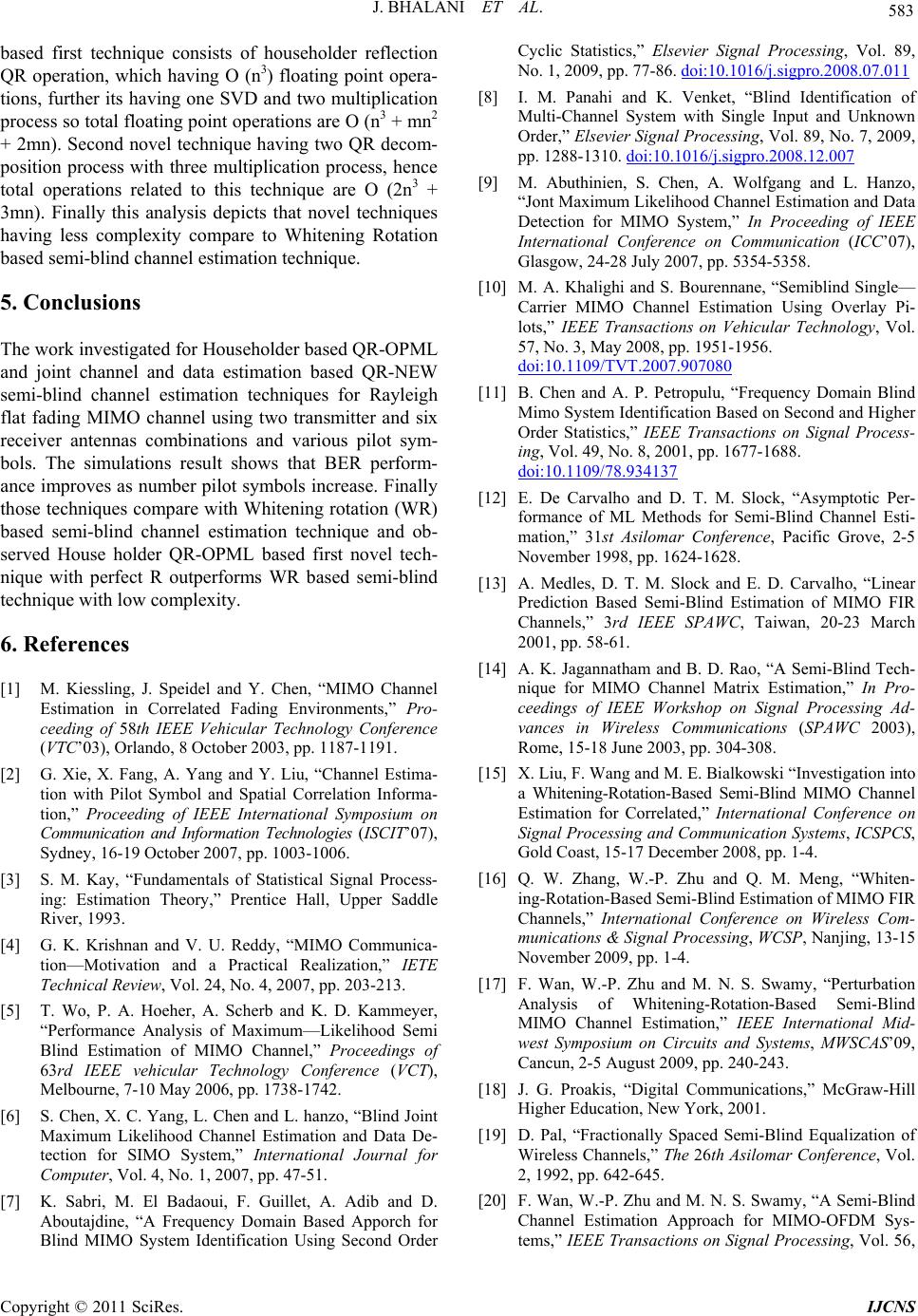
J. BHALANI ET AL.
Copyright © 2011 SciRes. IJCNS
583
based first technique consists of householder reflection
QR operation, which having O (n3) floating point opera-
tions, further its having one SVD and two multiplication
process so total floating point operations are O (n3 + mn2
+ 2mn). Second novel technique having two QR decom-
position process with three multiplication process, hence
total operations related to this technique are O (2n3 +
3mn). Finally this analysis depicts that novel techniques
having less complexity compare to Whitening Rotation
based semi-blind channel estimation technique.
5. Conclusions
The work investigated for Householder based QR-OPML
and joint channel and data estimation based QR-NEW
semi-blind channel estimation techniques for Rayleigh
flat fading MIMO channel using two transmitter and six
receiver antennas combinations and various pilot sym-
bols. The simulations result shows that BER perform-
ance improves as number pilot symbols increase. Finally
those techniques compare with Whitening rotation (WR)
based semi-blind channel estimation technique and ob-
served House holder QR-OPML based first novel tech-
nique with perfect R outperforms WR based semi-blind
technique with low complexity.
6. References
[1] M. Kiessling, J. Speidel and Y. Chen, “MIMO Channel
Estimation in Correlated Fading Environments,” Pro-
ceeding of 58th IEEE Vehicular Technology Conference
(VTC’03), Orlando, 8 October 2003, pp. 1187-1191.
[2] G. Xie, X. Fang, A. Yang and Y. Liu, “Channel Estima-
tion with Pilot Symbol and Spatial Correlation Informa-
tion,” Proceeding of IEEE International Symposium on
Communication and Information Technologies (ISCIT’07),
Sydney, 16-19 October 2007, pp. 1003-1006.
[3] S. M. Kay, “Fundamentals of Statistical Signal Process-
ing: Estimation Theory,” Prentice Hall, Upper Saddle
River, 1993.
[4] G. K. Krishnan and V. U. Reddy, “MIMO Communica-
tion—Motivation and a Practical Realization,” IETE
Technical Review, Vol. 24, No. 4, 2007, pp. 203-213.
[5] T. Wo, P. A. Hoeher, A. Scherb and K. D. Kammeyer,
“Performance Analysis of Maximum—Likelihood Semi
Blind Estimation of MIMO Channel,” Proceedings of
63rd IEEE vehicular Technology Conference (VCT),
Melbourne, 7-10 May 2006, pp. 1738-1742.
[6] S. Chen, X. C. Yang, L. Chen and L. hanzo, “Blind Joint
Maximum Likelihood Channel Estimation and Data De-
tection for SIMO System,” International Journal for
Computer, Vol. 4, No. 1, 2007, pp. 47-51.
[7] K. Sabri, M. El Badaoui, F. Guillet, A. Adib and D.
Aboutajdine, “A Frequency Domain Based Apporch for
Blind MIMO System Identification Using Second Order
Cyclic Statistics,” Elsevier Signal Processing, Vol. 89,
No. 1, 2009, pp. 77-86. doi:10.1016/j.sigpro.2008.07.011
[8] I. M. Panahi and K. Venket, “Blind Identification of
Multi-Channel System with Single Input and Unknown
Order,” Elsevier Signal Processing, Vol. 89, No. 7, 2009,
pp. 1288-1310. doi:10.1016/j.sigpro.2008.12.007
[9] M. Abuthinien, S. Chen, A. Wolfgang and L. Hanzo,
“Jont Maximum Likelihood Channel Estimation and Data
Detection for MIMO System,” In Proceeding of IEEE
International Conference on Communication (ICC’07),
Glasgow, 24-28 July 2007, pp. 5354-5358.
[10] M. A. Khalighi and S. Bourennane, “Semiblind Single—
Carrier MIMO Channel Estimation Using Overlay Pi-
lots,” IEEE Transactions on Vehicular Technology, Vol.
57, No. 3, May 2008, pp. 1951-1956.
doi:10.1109/TVT.2007.907080
[11] B. Chen and A. P. Petropulu, “Frequency Domain Blind
Mimo System Identification Based on Second and Higher
Order Statistics,” IEEE Transactions on Signal Process-
ing, Vol. 49, No. 8, 2001, pp. 1677-1688.
doi:10.1109/78.934137
[12] E. De Carvalho and D. T. M. Slock, “Asymptotic Per-
formance of ML Methods for Semi-Blind Channel Esti-
mation,” 31st Asilomar Conference, Pacific Grove, 2-5
November 1998, pp. 1624-1628.
[13] A. Medles, D. T. M. Slock and E. D. Carvalho, “Linear
Prediction Based Semi-Blind Estimation of MIMO FIR
Channels,” 3rd IEEE SPAWC, Taiwan, 20-23 March
2001, pp. 58-61.
[14] A. K. Jagannatham and B. D. Rao, “A Semi-Blind Tech-
nique for MIMO Channel Matrix Estimation,” In Pro-
ceedings of IEEE Workshop on Signal Processing Ad-
vances in Wireless Communications (SPAWC 2003),
Rome, 15-18 June 2003, pp. 304-308.
[15] X. Liu, F. Wang and M. E. Bialkowski “Investigation into
a Whitening-Rotation-Based Semi-Blind MIMO Channel
Estimation for Correlated,” International Conference on
Signal Processing and Communication Systems, ICSPCS,
Gold Coast, 15-17 December 2008, pp. 1-4.
[16] Q. W. Zhang, W.-P. Zhu and Q. M. Meng, “Whiten-
ing-Rotation-Based Semi-Blind Estimation of MIMO FIR
Channels,” International Conference on Wireless Com-
munications & Signal Processing, WCSP, Nanjing, 13-15
November 2009, pp. 1-4.
[17] F. Wan, W.-P. Zhu and M. N. S. Swamy, “Perturbation
Analysis of Whitening-Rotation-Based Semi-Blind
MIMO Channel Estimation,” IEEE International Mid-
west Symposium on Circuits and Systems, MWSCAS’09,
Cancun, 2-5 August 2009, pp. 240-243.
[18] J. G. Proakis, “Digital Communications,” McGraw-Hill
Higher Education, New York, 2001.
[19] D. Pal, “Fractionally Spaced Semi-Blind Equalization of
Wireless Channels,” The 26th Asilomar Conference, Vol.
2, 1992, pp. 642-645.
[20] F. Wan, W.-P. Zhu and M. N. S. Swamy, “A Semi-Blind
Channel Estimation Approach for MIMO-OFDM Sys-
tems,” IEEE Transactions on Signal Processing, Vol. 56,